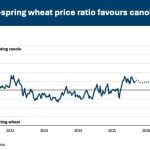Each month when Faye Oswald picks up her Tupperware container filled with fresh fruits and vegetables, she can’t wait for the surprise.
The Camrose, Alta., mother knows there will be apples oranges, bananas and potatoes in her Good Food Box, but she often tries to guess what new and interesting fruit and vegetable will be added.
“It’s like a present. What’s the surprise inside this month?”
This month the surprise was spinach and cabbage.
For many people spinach and cabbage may not seem like an exotic addition to the grocery cart, but for the program organizers, it’s just one more way of trying to get people to increase the number of fruits and vegetables they eat each day.
Read Also

Farmers urged to be grain-safe this fall
Working around grain bins comes with risk, from farmers falling to drowning in grain: Experts have five tips to help avoid grain-related accidents this harvest.
“In my house what’s in the box really influences what we eat,” said Jocelyn Shea, community nutritionist with the East Central regional health authority and partner in the Camrose Good Food Box program.
Introducing fruit and vegetables one food at a time is one way organizers hope to increase the amount of produce Canadians eat.
Few people meet Health Canada’s recommended five to 10 fruits and vegetables each day. Albertans eat an average 3.8 fruits and vegetables daily. In the east-central region of Alberta, it drops to 3.4 servings daily.
The Camrose program was launched in September 2003 with 20 members willing to pay $10 a month for the container full of fruit and vegetables. Six months later, the program has grown to 100 members.
“A lot of people say, ‘this is the most fruit and vegetables I’ve eaten in my life,’ ” said Shea.
Word of mouth and seeing the produce in the box are the best sales tools to promote the program. This month there were 13 new members.
The membership is as varied as the food, from single parents searching for inexpensive ways to stretch their food dollars to double income families looking for convenience to seniors who don’t like shopping.
Jo-Anne Tweed of Camrose thinks the program is a worthwhile addition to the community. As a single mother juggling work, college and two boys, it’s also a convenient way to shop for fresh fruit and vegetables.
“It reaches out to a lot of working parents that are struggling to pay the bills. This is a great thing the community is doing to help get healthy food into your home.”
Through the Good Food Box program, Walter Petterson of Camrose and his family have been introduced to a variety of new foods. Since joining the program he has eaten mangos, kiwi fruit, bok choy and squash.
“The squash was very good,” said Petterson, who enjoys the variety.
The fresh spinach in this month’s box was not what Petterson would have chosen if he’d done his own shopping, but it will still get eaten.
“The spinach will take a little getting used to, but we’ll work with it,” he said.
Along with the food, there is a newsletter with tidbits on how to store and cook the food, ways to sneak vegetables into the diet and the phone number of the local nutritionist. This month Shea included her favourite cabbage and spinach salad recipes to help people use the vegetables.
Petterson said last month his wife was curious how much money they save by buying through the program. She estimated they were getting about $20 of fruit and vegetables for $10.
“The prices are reasonable,” said Petterson, who was picking up a box for himself and another for his son’s family.
The Good Food Box program in Tisdale, Sask., was the first of its kind to be launched in a rural area. It began there in November 2001 as a diabetes prevention program and has since expanded to 200 members in 12 communities including the nearby towns of Melfort, Nipawin and several First Nations communities farther north.
Like in Camrose, the members include everyone from single parents looking for ways to stretch their monthly budget to people who don’t like to shop for groceries, said Jacki Abraham, regional co-ordinator for the program in Tisdale.
The program has been so successful some members want deliveries twice a month.
Unsure of amount
Despite its popularity Abraham can’t be sure if there has been an increase in the amount of fruit and vegetables eaten by the members or a lowering of the diabetes rate. Once the vegetables are gone from the food box Abraham doesn’t know how many people buy additional fruit and vegetables.
Unlike southern towns and cities, access to fresh fruit and vegetables is a problem in the north, especially in First Nations communities where the only store is likely to be a convenience store and not a grocery store with inexpensive fresh fruit. Because of the limited availability of produce, some communities send drivers five hours to Tisdale to pick up their Good Food Boxes each month.
“Transportation is a big barrier,” said Abraham.
Each month when Abraham plans the food box, she searches the fliers for sales and specials to make the $2,400 food budget divide into 200 overflowing food boxes.
For her members, the addition of cantaloupe or cauliflower is a welcome variety.
“Our unusual (food item) is not weird. We keep it very basic.”














